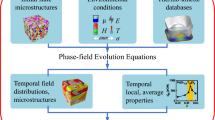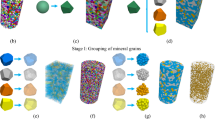Abstract
Computational models of representative volumes of metal matrix composites are crucial for investigating material behavior on the microscale. Numerical simulations often employ finite element models of representative volumes. Such models are based on observations of material microstructural properties, for example, by means of electron microscopy. Constructing a geometrical model of a representative volume for further computations can be a tedious task. This paper presents a new approach to creating geometrical models of this kind. The approach is based on the simulation of rigid body motion in a gravitational field and allows one to automatically generate geometrical models of representative volumes. The approach capabilities are exemplified by two geometrical models of representative volume. One model describes a metal matrix composite with high volume fraction of prismatic reinforcement particles, produced by liquid metal infiltration. The other model describes a metal matrix composite with high volume fraction of metal pellets, produced by powder metallurgy.





Similar content being viewed by others
References
Peters S (2013) Handbook of composites. Springer, Boston
Chawla K (2012) Composite materials: science and engineering. Springer, New York
Xue-bin L, Hua-min Z, Chun Z, Chao S (2000) A study of residual stress field in whisker reinforced metallic composite by using 3-D FEM. Wuhan Univ J Nat Sci. https://doi.org/10.1007/BF02828306
Su Y, Ouyang Q, Zhang W et al (2014) Composite structure modeling and mechanical behavior of particle reinforced metal matrix composites. Mater Sci Eng A. https://doi.org/10.1016/j.msea.2014.01.024
Schoutens JE (1984) Simple and precise measurements of fibre volume and void fractions in metal matrix composite materials. J Mater Sci. https://doi.org/10.1007/BF00540466
Lee WJ, Kim YJ, Kang NH, Park IM, Park YH (2011) Finite-element modeling of the particle clustering effect in a powder-metallurgy-processed ceramic-particle-reinforced metal matrix composite on its mechanical properties. Mech Compos Mater. https://doi.org/10.1007/s11029-011-9177-y
Mishnaevsky L (2007) Computational experiments in the mechanics of materials: concepts and tools. Wiley, New York
Umer U, Ashfaq M, Qudeiri JA et al (2015) Modeling machining of particle-reinforced aluminum-based metal matrix composites using cohesive zone elements. Int J Adv Manuf Technol. https://doi.org/10.1007/s00170-014-6715-5
Gusev AA (1997) Representative volume element size for elastic composites: a numerical study. J Mech Phys Solids. https://doi.org/10.1016/S0022-5096(97)00016-1
Ayyar A, Chawla N (2007) Three-dimensional (3D) microstructure-based modeling of crack growth in particle reinforced composites. J Mat Sci. https://doi.org/10.1007/s10853-007-2010-2
Williams J, Segurado J, LLorca J, Chawla N (2012) Three dimensional (3D) microstructure-based modeling of interfacial decohesion in particle reinforced metal matrix composites. Mater Sci Eng A. https://doi.org/10.1016/j.msea.2012.05.108
Hill R (1963) Elastic properties of reinforced solids: some theoretical principles. J Mech Phys Solids 11:357–372
Ostoja-Starzewski M (2006) Material spatial randomness: from statistical to representative volume element. Probab Eng Mech 21:112–131
Drugan WJ, Willis JR (1996) A micromechanics-based nonlocal constitutive equation and estimates of representative volume element size for elastic composites. J Mech Phys Solids 44(4):497–524
Coffman VR, Reid ACE, Langer SA, Dogan G (2013) OOF3D: an image-based finite element solver for materials science. Appl Imaging Tech Mech Mater Struct. https://doi.org/10.1007/978-1-4419-9796-8_47
3D Image Processing: https://www.synopsys.com/simpleware.html. Accessed 11 Oct 2018
Han W, Eckschlager A, Böhm HJ (2001) The effects of three-dimensional multi-particle arrangements on the mechanical behavior and damage initiation of particle-reinforced MMCs. Compos Sci Technol. https://doi.org/10.1016/S0266-3538(01)00061-6
Böhm HJ, Han W (2001) Comparisons between three-dimensional and two-dimensional multi-particle unit cell models for particle reinforced metal matrix composites. Model Simul Mater Sci Eng. https://doi.org/10.1088/0965-0393/9/2/301
Eckschlager A, Han W, Böhm HJ (2002) A unit cell model for brittle fracture of particles embedded in a ductile matrix. Comput Mater Sci. https://doi.org/10.1016/S0927-0256(02)00252-5
Segurado J, Gonzalez C, LLorca J (2003) A numerical investigation of the effect of particle clustering on the mechanical properties of composites. Acta Mater. https://doi.org/10.1016/S1359-6454(03)00043-0
Qian Z, Garboczi EJ, Ye G, Schlangen E (2016) Anm: a geometrical model for the composite structure of mortar and concrete using real shape particles. MaterStruct 49:149–158
Böhm HJ, Eckschlager A, Han W (2002) Multi-inclusion unit cell models for metal matrix composites with randomly oriented discontinuous reinforcements. Comp Mater Sci. https://doi.org/10.1016/S0927-0256(02)00248-3
Atkins SL, Gibeling JC (1995) A finite element model of the effects of primary creep in an Al-SiC metal matrix composite. Metall Mater Trans A. https://doi.org/10.1007/BF02669437
Fritzen F, Böhlke T (2011) Periodic three-dimensional mesh generation for particle reinforced composites with application to metal matrix composites. Int J Solids Struct. https://doi.org/10.1016/j.ijsolstr.2010.11.010
Bagi K (1993) A quasi-static numerical model for micro-level analysis of granular assemblies. Mech Mater. https://doi.org/10.1016/0167-6636(93)90032-M
Hitti K, Laure P, Coupez T, Silva L, Bernacki M (2012) Precise generation of complex statistical Representative Volume Elements (RVEs) in a finite element context. Comp Mater Sci. https://doi.org/10.1016/j.commatsci.2012.04.011
Buryachenko VA, Jackson T, Amadio G (2012) Modeling of random bimodal structures of composites (application to solid propellant): I. simulation of random packs. Comput Model Eng Sci 85(5):379–416
Jia X, Williams RA (1001) A packing algorithm for particles of arbitrary shape. Powder Technol 120:175–186
Burtseva L, Salas BV, Romero R, Werner F (2016) Recent advances on modelling of structures of multi-component mixtures using a sphere packing approach. Int J Nanotech. https://doi.org/10.1504/IJNT.2016.074522
Woodcock NH, Naylor MA (1983) Randomness testing in threedimensional orientation data. J Struct Geol 5:539–548
Home of Bullet and PyBullet: physics simulation for games, visual effects, robotics and reinforcement learning. http://bulletphysics.org/. Accessed 11 Oct 2018
Smirnov SV, Konovalov AV, Myasnikova MV, Khalevitsky YV, Smirnov AS, Igumnov AS (2016) A hierarchial modeling of stress-strain state of multiphase materialsubjected to uniaxial loading. In: AIP conference proceedings, vol. 1785. https://doi.org/10.1063/1.4967123
Acknowledgements
This work was partially supported by Russian Sсience Foundation (Project 14-19-01358) in the part of metal matrix composite model development.
Author information
Authors and Affiliations
Corresponding author
Additional information
Publisher’s Note
Springer Nature remains neutral with regard to jurisdictional claims in published maps and institutional affiliations.
Rights and permissions
About this article
Cite this article
Khalevitsky, Y.V., Konovalov, A.V. A gravitational approach to modeling the representative volume geometry of particle-reinforced metal matrix composites. Engineering with Computers 35, 1037–1044 (2019). https://doi.org/10.1007/s00366-018-0649-8
Received:
Accepted:
Published:
Issue Date:
DOI: https://doi.org/10.1007/s00366-018-0649-8




